GMC Sierra 2500hd 2019 Owner's Manual
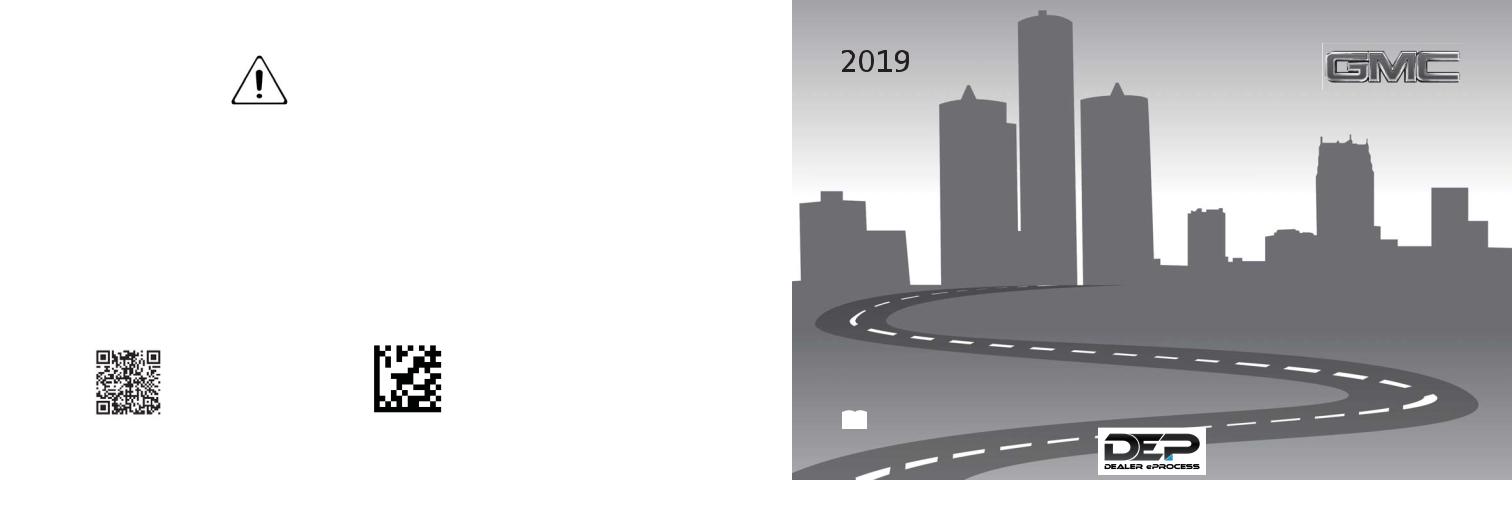
Sierra Limited 1500 and Sierra/Sierra Denali 2500/3500
Owner’s Manual
gmc.com (U.S.) gmccanada.ca (Canada)
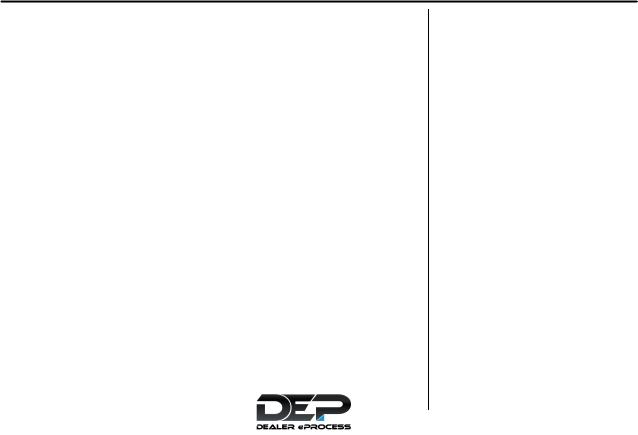
Contents
Introduction . . . . . . . . . . . . . . . . . . . . . . 2
In Brief . . . . . . . . . . . . . . . . . . . . . . . . . . . 5
Keys, Doors, and Windows . . . . . 33
Seats and Restraints . . . . . . . . . . . 55
Storage . . . . . . . . . . . . . . . . . . . . . . . 122
Instruments and Controls . . . . . . 126
Lighting . . . . . . . . . . . . . . . . . . . . . . . 174
Infotainment System . . . . . . . . . . 185
Climate Controls . . . . . . . . . . . . . . 220
Driving and Operating . . . . . . . . . 229
Vehicle Care . . . . . . . . . . . . . . . . . . 328
Service and Maintenance . . . . . 432
Technical Data . . . . . . . . . . . . . . . . 449
Customer Information . . . . . . . . . 453
Reporting Safety Defects . . . . . . 464
OnStar . . . . . . . . . . . . . . . . . . . . . . . . 467
Connected Services . . . . . . . . . . . 475
Index . . . . . . . . . . . . . . . . . . . . 479

2Introduction
Introduction
The names, logos, emblems, slogans, vehicle model names, and vehicle body designs appearing in this manual including, but not limited to, GM, the GM logo, GMC, the GMC Truck Emblem, SIERRA, and DENALI are trademarks and/or service marks of General Motors LLC, its subsidiaries, affiliates,
or licensors.
For vehicles first sold in Canada, substitute the name “General Motors of Canada Company” for GMC Division wherever it appears in this manual.
This manual describes features that may or may not be on the vehicle because of optional equipment that was not purchased on the vehicle, model variants, country specifications, features/applications that may not be available in your region, or changes subsequent to the printing of this owner’s manual.
If the vehicle has the Duramax diesel engine, see the Duramax diesel supplement for additional and specific information on this engine.
Refer to the purchase documentation relating to your specific vehicle to confirm the features.
Keep this manual in the vehicle for quick reference.
Canadian Vehicle Owners
A French language manual can be obtained from your dealer, at www.helminc.com, or from:
Propriétaires Canadiens
On peut obtenir un exemplaire de ce guide en français auprès du concessionnaire ou à l'adresse suivante:
Helm, Incorporated
Attention: Customer Service
47911 Halyard Drive
Plymouth, MI 48170
USA
Using this Manual
To quickly locate information about the vehicle, use the Index in the back of the manual. It is an alphabetical list of what is in the manual and the page number where it can be found.
Litho in U.S.A. |
|
Part No. 84161701 A First Printing |
2018 General Motors LLC. All Rights Reserved. |

Introduction 3
Danger, Warning, and
Caution
Warning messages found on vehicle labels and in this manual describe hazards and what to do to avoid or reduce them.
{Danger
Danger indicates a hazard with a high level of risk which will result in serious injury or death.
{Warning
Warning indicates a hazard that could result in injury or death.
Caution
Caution indicates a hazard that could result in property or vehicle damage.
A circle with a slash through it is a safety symbol which means “Do Not,” “Do not do this,” or “Do not let this happen.”
Symbols
The vehicle has components and labels that use symbols instead of text. Symbols are shown along with the text describing the operation or information relating to a specific component, control, message, gauge, or indicator.
M : Shown when the owner’s manual has additional instructions or information.
* : Shown when the service manual has additional instructions or information.
0 : Shown when there is more information page — “see
Vehicle Symbol Chart
Here are some additional symbols that may be found on the vehicle and what they mean. See the features in this manual for information.
u : Air Conditioning System
G : Air Conditioning Refrigerant Oil
9 : Airbag Readiness Light
! : Antilock Brake System (ABS) $ : Brake System Warning Light
9: Dispose of Used Components Properly
B : Engine Coolant Temperature
_ : Flame/Fire Prohibited
H : Flammable
[: Forward Collision Alert
+ : Fuses
j : ISOFIX/LATCH System Child Restraints
|: Lane Change Alert
@ : Lane Departure Warning
A : Lane Keep Assist

4Introduction
* : Malfunction Indicator Lamp
: : Oil Pressure
X: Park Assist
~ : Pedestrian Ahead Indicator
O : Power
7: Rear Cross Traffic Alert
I : Registered Technician
/ : Remote Vehicle Start
> : Seat Belt Reminders
I : Side Blind Zone Alert
h : Start/Stop
7 : Tire Pressure Monitor
d : StabiliTrak/Electronic Stability
Control (ESC)
a : Under Pressure
V: Vehicle Ahead Indicator

In Brief |
5 |
In Brief
Instrument Panel
Instrument Panel . . . . . . . . . . . . . . . . 6
Initial Drive Information
Initial Drive Information . . . . . . . . . . 8
Remote Keyless Entry (RKE)
System . . . . . . . . . . . . . . . . . . . . . . . . 8
Remote Vehicle Start . . . . . . . . . . . 9
Door Locks . . . . . . . . . . . . . . . . . . . . . 9
Windows . . . . . . . . . . . . . . . . . . . . . . . 10
Seat Adjustment . . . . . . . . . . . . . . . 11
Memory Features . . . . . . . . . . . . . . 13
Heated and Ventilated Seats . . . 13
Head Restraint Adjustment . . . . 14
Seat Belts . . . . . . . . . . . . . . . . . . . . . 14
Passenger Sensing System . . . 14
Mirror Adjustment . . . . . . . . . . . . . . 15
Steering Wheel Adjustment . . . . 16
Throttle and Brake Pedal
Adjustment . . . . . . . . . . . . . . . . . . . 17
Interior Lighting . . . . . . . . . . . . . . . . 17
Exterior Lighting . . . . . . . . . . . . . . . 18
Windshield Wiper/Washer . . . . . . 19
Climate Controls . . . . . . . . . . . . . . . 20
Transmission . . . . . . . . . . . . . . . . . . 22
Four-Wheel Drive . . . . . . . . . . . . . . 23
Vehicle Features
Infotainment System . . . . . . . . . . . 24
Radio(s) . . . . . . . . . . . . . . . . . . . . . . . 24
Satellite Radio . . . . . . . . . . . . . . . . . 25
Portable Audio Devices . . . . . . . . 25
Bluetooth . . . . . . . . . . . . . . . . . . . . . . 25
Steering Wheel Controls . . . . . . . 25
Cruise Control . . . . . . . . . . . . . . . . . 26
Driver Information
Center (DIC) . . . . . . . . . . . . . . . . . 26
Forward Collision Alert (FCA)
System . . . . . . . . . . . . . . . . . . . . . . . 27
Forward Automatic
Braking (FAB) . . . . . . . . . . . . . . . . 27
Lane Departure
Warning (LDW) . . . . . . . . . . . . . . . 27
Lane Keep Assist (LKA) . . . . . . . 27
Rear Vision Camera (RVC) . . . . 28
Park Assist . . . . . . . . . . . . . . . . . . . . 28
Power Outlets . . . . . . . . . . . . . . . . . 28
Universal Remote System . . . . . 29
Sunroof . . . . . . . . . . . . . . . . . . . . . . . . 29
Performance and Maintenance
Traction Control/Electronic |
|
Stability Control . . . . . . . . . . . . . . |
30 |
Tire Pressure Monitor . . . . . . . . . . |
30 |
Fuel (Diesel) . . . . . . . . . . . . . . . . . . . |
31 |
Fuel (Gasoline) . . . . . . . . . . . . . . . . |
31 |
E85 . . . . . . . . |
31 |
Engine Oil Life System . . . . . . . . 31 Driving for Better Fuel
Economy . . . . . . . . . . . . . . . . . . . . . 32 Roadside Assistance
Program . . . . . . . . . . . . . . . . . . . . . . 32

6In Brief
Instrument Panel
Uplevel Shown, Base Similar

In Brief |
7 |
1.Instrument Panel Illumination Control 0 181.
2.Integrated Trailer Brake Control (ITBC) System (If Equipped). See Towing Equipment 0 311.
3.Exterior Lamp Controls 0 174.
Fog Lamps 0 179 (If Equipped).
4.Air Vents 0 227.
5.Turn Signal Lever. See Turn and Lane-Change Signals 0 179.
Windshield Wiper/Washer 0 128.
6.Favorite Switches (Out of View). See Steering Wheel Controls 0 127.
Volume Switches (Out of View). See Steering Wheel Controls
0 127.
7.Instrument Cluster 0 136.
8.Hazard Warning Flashers 0 178.
9.Shift Lever. See Automatic Transmission 0 260.
Tow/Haul Selector Button (If
Equipped). See Tow/Haul
Mode 0 266.
Range Selection Mode (If
Equipped). See Manual Mode
0263.
10.Light Sensor. See Automatic Headlamp System 0 177.
11.Infotainment 0 185.
12.Passenger Airbag On-Off Switch (If Equipped) (Out of View). See Airbag On-Off Switch 0 82.
13.Heated and Ventilated Front Seats 0 63 (If Equipped).
14.Power Outlet 110/120V Alternating Current (If Equipped). See Power Outlets
0130.
15.Power Outlets 0 130 (If Equipped).
16.USB Port 0 194 (If Equipped).
17.g Traction Control/Electronic Stability Control 0 277.
0 Pedal Adjust Switch (If Equipped). See Adjustable Throttle and Brake Pedal 0 250.
{Exterior Cargo Lamps 0 180.
X Park Assist Button (If Equipped). See Assistance Systems for Parking or Backing 0 285.
ALane Keep Assist (LKA)
(1500 Series) 0 292 (If
Equipped).
@Lane Departure Warning
(LDW) (2500/3500 Series)
0 291 (If Equipped).
5 Hill Descent Control Switch
(If Equipped). See Hill Descent
Control (HDC) 0 279.
q Exhaust Brake Switch (If Equipped). See “Exhaust Brake” in the Duramax diesel supplement.

8In Brief
g Power Take Off (PTO) Switch (If Equipped). See the Duramax diesel supplement.
Auxiliary Button (If Equipped).
See Add-On Electrical
Equipment 0 323.
j Power Assist Steps 0 42 (If
Equipped).
18.Dual Automatic Climate Control System 0 224 (If Equipped).
19.Steering Wheel Controls 0 127
(If Equipped).
Driver Information Center (DIC) Controls. See Driver Information Center (DIC) (Uplevel and Denali Cluster)
0 158 or Driver Information Center (DIC) (Base Level Cluster) 0 157.
20.Hood Release. See Hood
0 332.
21.Horn 0 128.
22.Steering Wheel Adjustment
0 127 (Out of View).
23.Cruise Control 0 280.
Heated Steering Wheel 0 128
(If Equipped).
Forward Collision Alert (FCA) System 0 287 (If Equipped).
24.Data Link Connector (DLC) (Out of View). See Malfunction Indicator Lamp (Check Engine Light) 0 148.
25.Parking Brake 0 276.
26.Electronic Transfer Case Knob (If Equipped). See Four-Wheel Drive 0 267.
Card Holder (If Equipped). See
Instrument Panel Storage 0 122.
Initial Drive
Information
This section provides a brief overview about some of the important features that may or may not be on your specific vehicle.
For more detailed information, refer to each of the features which can be found later in this owner’s manual.
Remote Keyless Entry
(RKE) System
The Remote Keyless Entry (RKE) transmitter functions may work from up to 60 m (197 ft) away from the vehicle.

In Brief |
9 |
K : Press to unlock the driver door. Press K again within three seconds to unlock all remaining doors and the tailgate, if equipped.
Q : Press to lock all doors and the tailgate. Lock and unlock feedback can be personalized. See Vehicle Personalization 0 163.
7 : Press and release one time to initiate vehicle locator. Press 7 and hold for at least three seconds to sound the panic alarm. Press 7 again to cancel the panic alarm.
See Keys 0 33 and Remote Keyless Entry (RKE) System Operation 0 36.
Remote Vehicle Start
If equipped, the engine can be started from outside of the vehicle.
Starting the Vehicle
1.Press and release Q on the RKE transmitter.
2.Immediately press and hold / for at least four seconds or until the turn signal lamps flash.
Start the vehicle normally after entering.
When the vehicle starts, the parking lamps will turn on.
Remote start can be extended.
Canceling a Remote Start
To cancel a remote start, do one of the following:
.Press and hold / until the parking lamps turn off.
.Turn on the hazard warning flashers.
. Turn the vehicle on and then off.
See Remote Vehicle Start 0 38.
Door Locks
There are several ways to lock and unlock the vehicle.
From outside, use the Remote Keyless Entry (RKE) transmitter or the key in the driver door.
From inside, use the power door locks.
From inside, pull the door handle once to unlock the door. Pull again to open the door.

10 In Brief
Power Door Locks |
Windows |
Power Sliding Rear Window |
|
Power Windows |
|
Crew/Double Cab Premium Trim Shown, Other Models Similar
Q : Press to lock the doors.
K : Press to unlock the doors.
See Door Locks 0 39 and Power Door Locks 0 40.
Crew/Double Cab Premium Trim
Shown, Other Models Similar
Power windows work when the ignition is on, in ACC/ACCESSORY, or when Retained Accessory Power (RAP) is active. See Retained Accessory Power (RAP) 0 255.
Using the window switch, press to open or pull to close the window.
The windows may be temporarily disabled if they are used repeatedly within a short time.
If equipped, the power sliding rear window works when the ignition has been turned on or to ACC/ ACCESSORY, or when Retained Accessory Power (RAP) is active. See Retained Accessory Power (RAP) 0 255.
Using the window switch, press to open or pull to close the window.
The power sliding rear window cannot be operated manually. See “Power Sliding Rear Window” in
Rear Windows 0 52.
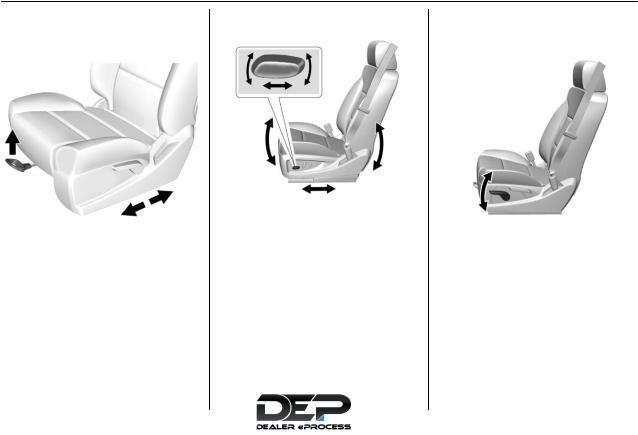
|
|
In Brief |
11 |
Seat Adjustment |
Power Seats |
Lumbar Adjustment |
|
Manual Seats |
|
Manual Lumbar |
|
To adjust a manual seat:
1.Pull the handle at the front of the seat.
2.Slide the seat to the desired position and release the handle.
3.Try to move the seat back and forth to be sure it is locked in place.
See Seat Adjustment 0 57.
To adjust a power seat, if equipped:
.Move the seat forward or rearward by sliding the control forward or rearward.
.If equipped, raise or lower the front part of the seat cushion by moving the front of the control up or down.
.If equipped, raise or lower the seat by moving the rear of the control up or down.
See Power Seat Adjustment 0 58.
If equipped, move the lever up or down repeatedly to increase or decrease lumbar support.
See Lumbar Adjustment 0 58.
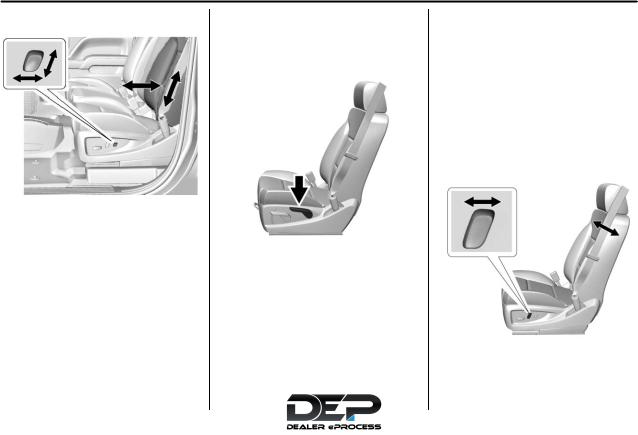
12 In Brief
Power Lumbar
To adjust the power lumbar support, if equipped:
.Press and hold the control forward to increase or rearward to decrease upper and lower lumbar support at the same time.
.If equipped, press and hold the control up to increase upper lumbar support and decrease lower lumbar support.
Press and hold the control down to increase lower lumbar support and decrease upper lumbar support.
See Lumbar Adjustment 0 58.
Reclining Seatbacks
Manual Reclining Seatbacks
To adjust a manual seatback:
1.Lift the lever.
The seatback will automatically fold forward.
2.To recline, move the seatback rearward to the desired position, then release the lever to lock the seatback in place.
3.Push and pull on the seatback to make
To return the seatback to the upright position:
1.Lift the lever fully without applying pressure to the seatback, and the seatback will return to the upright position.
2.Push and pull on the seatback to make sure it is locked.
See Reclining Seatbacks 0 59.
Power Reclining Seatbacks
To recline a power seatback, if equipped:
.Tilt the top of the control rearward to recline.
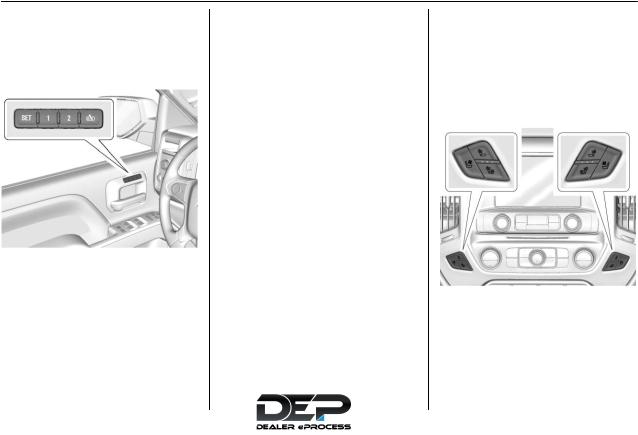
In Brief |
13 |
.Tilt the top of the control forward to raise.
See Reclining Seatbacks 0 59.
Memory Features
Crew/Double Cab Shown, Other
Models Similar
If equipped, memory seats allow two drivers to save and recall their unique seat positions for driving the vehicle, and a shared exit position for getting out of the vehicle. Other feature positions may also be saved, such as power mirrors and power steering wheel, if equipped.
Memory positions are linked to RKE transmitter 1 or 2 for automatic memory recalls.
Before saving, adjust all available memory feature positions. Turn the ignition on and then press and release SET; a beep will sound. Then immediately press and hold 1,
2, or B (Exit) until two beeps sound. To manually recall these positions, press and hold 1, 2, or B until the saved position is reached.
When Auto Memory Recall is enabled in vehicle personalization, positions previously saved to memory buttons 1 and 2 are recalled when the ignition is changed from off to on or ACC/ ACCESSORY.
When Easy Exit Options is enabled in vehicle personalization, the feature automatically recalls the previously saved exit position when exiting the vehicle.
Memory adjustments may not be available upon delivery or after service until steps in “Saving Memory Positions” section are performed. See Memory Seats 0 60.
Heated and Ventilated
Seats
Heated and Ventilated Seat
Buttons Shown, Heated Seat
Buttons Similar
If equipped, the buttons are on the center stack. To operate, the engine must be running.
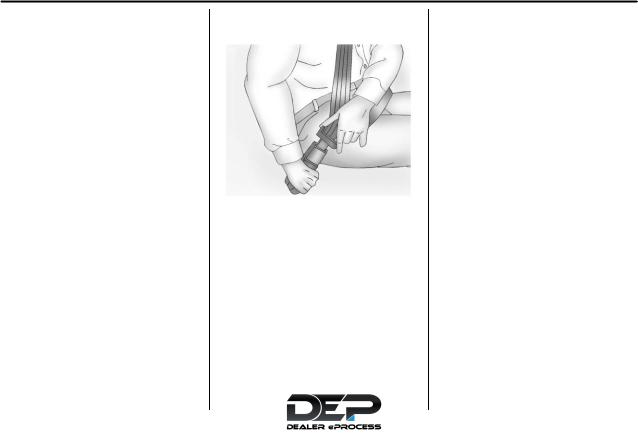
14 In Brief
Press I to heat the driver or passenger seatback only.
Press J to heat the driver or passenger seat cushion and seatback.
PressC to ventilate the driver or passenger seat.
See Heated and Ventilated Front
Seats 0 63.
Head Restraint
Adjustment
Do not drive until the head restraints for all occupants are installed and adjusted properly.
To achieve a comfortable seating position, change the seatback recline angle as little as necessary while keeping the seat and the head restraint height in the proper position.
See Head Restraints 0 56 and Power Seat Adjustment 0 58.
Seat Belts
Refer to the following sections for important information on how to use seat belts properly:
.Seat Belts 0 67
.How to Wear Seat Belts Properly 0 68
.Lap-Shoulder Belt 0 70
.Lower Anchors and Tethers for Children (LATCH System) 0 98
Passenger Sensing
System
The passenger sensing system, if equipped, turns off the front outboard passenger frontal airbag under certain conditions. No other
airbag is affected by the passenger sensing system.
If the vehicle has one of the indicators pictured in the following illustrations, then the vehicle has a passenger sensing system for the front outboard passenger position unless there is an airbag off switch on the instrument panel endcap.
If there is an airbag off switch, the vehicle does not have a passenger sensing system. See Airbag On-Off Switch 0 82 for more information.
The passenger airbag status indicator will be visible on the overhead console when the vehicle is started.

In Brief |
15 |
United States
Canada
See Passenger Sensing System
0 84 for important information.
Mirror Adjustment
Using hood-mounted air deflectors and add-on convex mirror attachments could decrease mirror performance.
Exterior Mirrors
Manual Mirrors
If equipped, adjust manual mirrors by moving them up and down or left to right to see a little of the side of the vehicle and to have a clear view behind the vehicle.
See Manual Mirrors 0 45.
Power Mirrors
If equipped with power mirrors:
1.Press (1) or (2) to select the driver or passenger side mirror.
2.Press the arrows on the control pad to move the mirror up, down, right, or left.
3.Adjust each outside mirror so that a little of the vehicle and the area behind it can be seen.
4.Keep the selector switch in the center position when not adjusting either outside mirror.
1.Press (1) or (3) to select the driver or passenger side mirror.

16 In Brief
2.Press the arrows on the control pad while the indicator light on the (1) or (3) button is illuminated, to move the mirror up, down, right, or left.
3.Adjust each outside mirror so that a little of the vehicle and the area behind it can be seen.
4.Press either (1) or (3) again to deselect the mirror.
See Power Mirrors 0 46.
If equipped with power folding mirrors:
1.Press (2) to fold the mirrors out to the driving position.
2.Press (2) again to fold the mirrors in to the folded position.
For manual, power, and auto folding mirrors, see Folding Mirrors 0 47.
The mirrors may also include a memory function that works with the memory seats. See Memory Seats
0 60.
Interior Mirror
Adjustment
Adjust the mirror for a clear view of the area behind the vehicle.
Manual Dimming Rearview Mirror
If equipped, push the tab forward for daytime use and pull it for nighttime use to avoid glare from the headlamps from behind. See
Manual Rearview Mirror 0 49.
Automatic Dimming Rearview
Mirror
If equipped, the mirror will automatically reduce the glare of the headlamps from behind. The dimming feature comes on when the vehicle is started.
See Automatic Dimming Rearview Mirror 0 49 or Automatic Dimming Rearview Mirror 0 49.
Steering Wheel
Adjustment
To adjust the steering wheel:
1.Hold the steering wheel and pull the lever.
2.Move the steering wheel up or down.
3.Release the lever to lock the wheel in place.

In Brief |
17 |
Tilt and Telescoping Steering
Wheel
To adjust the tilt and telescoping steering wheel, if equipped:
1.Push the lever (1) down to move the steering wheel forward or rearward. Lift the lever up to lock the wheel in place.
2.Pull the lever (2) toward you to move the steering wheel up or down, then release the lever to lock the wheel in place.
Do not adjust the steering wheel while driving.
Throttle and Brake Pedal
Adjustment
If equipped, the position of the throttle and brake pedals can be changed.
The switch used to adjust the pedals is on the center stack, below the climate controls.
Lift the switch up to move the pedals closer to your body. Press the switch down to move the pedals away.
See Adjustable Throttle and Brake
Pedal
Interior Lighting
Dome Lamps
There are dome lamps in the overhead console and the headliner, if equipped.
To change the dome lamp settings, press the following:
OFF : Turns the lamps off, even when a door is open.
DOOR : The lamps come on automatically when a door is opened.
ON : Turns all dome lamps on.
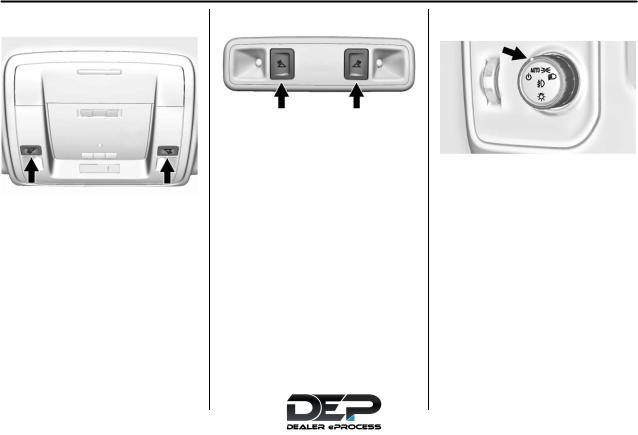
18 In Brief
Reading Lamps |
Exterior Lighting |
Press m or n next to each reading lamp to turn it on or off.
For more information about interior lighting, see Instrument Panel
Illumination Control 0 181.
There are reading lamps in the overhead console and the headliner, if equipped. To operate, the ignition must be on or in ACC/ACCESSORY or using Retained Accessory
Power (RAP).
The exterior lamp control is on the instrument panel to the left of the steering wheel.
O : Turns off the automatic headlamps and Daytime Running Lamps (DRL). Turn the headlamp
control to O again to turn the automatic headlamps or DRL back on.
For vehicles first sold in Canada, off will only work when the vehicle is in P (Park).
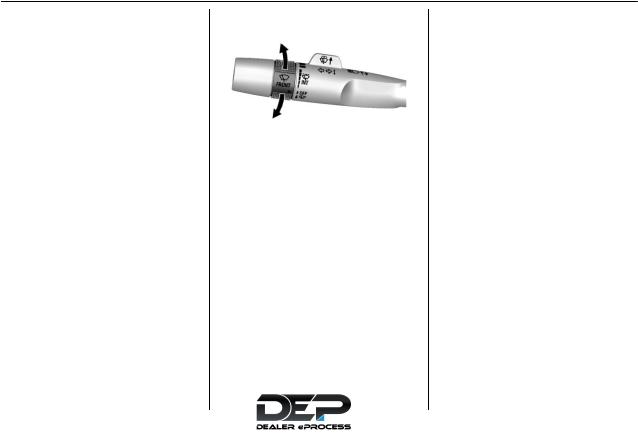
In Brief |
19 |
AUTO : Automatically turns on the headlamps, parking lamps, taillamps, instrument panel lights, roof marker lamps (if equipped), front/rear sidemarker lamps, and license plate lamps.
; : Turns on the parking lamps including all lamps, except the headlamps.
5 : Turns on the headlamps together with the parking lamps and instrument panel lights.
See:
.Exterior Lamp Controls 0 174.
.Daytime Running Lamps (DRL) 0 177.
.Fog Lamps 0 179.
Windshield Wiper/Washer
The windshield wiper control is on the turn signal lever.
The windshield wipers are controlled by turning the band with zon it.
1 : Fast wipes. w : Slow wipes.
3 INT : Turn the band up for more frequent wipes or down for less frequent wipes.
OFF : Turns the windshield wipers off.
8 : For a single wipe, turn to 8, then release. For several wipes,
hold the band on 8 longer.
Lm : Push the paddle at the top of the lever to spray washer fluid on the windshield.
See Windshield Wiper/Washer 0 128.

20 In Brief
Climate Controls
These systems control the heating, cooling, and ventilation.
Climate Control System (with Heater Only)
1. |
Fan Control |
4. |
Defrost |
2. |
Air Recirculation |
5. |
TEMP (Temperature Control) |
3. |
Air Delivery Mode Control |
|
|

In Brief |
21 |
Climate Control System (with Air Conditioning)
1. |
Fan Control |
6. |
K(Rear Window Defogger, If |
2. |
A/C (Air Conditioning) |
|
Equipped) |
3. |
Air Delivery Mode Control |
|
f (Outside Heated Mirror, If |
4. |
Defrost |
|
Equipped) |
|
|
||
5. |
TEMP (Temperature Control) |
|
8 (Outside Air, If Equipped) |
|
|
7. |
Air Recirculation |

22 |
In Brief |
|
Dual Automatic Climate Control System |
Transmission |
|
|
|
Range Selection Mode |
1. |
Driver Temperature Control |
8. |
Rear Window Defogger |
2. |
A/C (Air Conditioning) |
9. |
Power Button |
3. |
Air Delivery Mode Controls |
10. |
Air Recirculation |
4. |
Fan Control |
11. |
AUTO (Automatic Operation) |
5. |
Defrost |
See Dual Automatic Climate Control |
|
6. |
Passenger Temperature |
System 0 224. |
|
|
|
||
Control
7.SYNC (Synchronized Temperature)
The Range Selection Mode switch, if equipped, is on the shift lever.
1.To enable the Range Selection feature, move the shift lever to the L (Manual Mode) position. The current range will appear next to the L. This is the highest attainable range with all lower gears accessible. As an example, when 5 (Fifth) gear is selected, 1 (First) through 5 (Fifth) gears are available.
2.Press the plus/minus buttons on the shift lever to select the desired range of gears for current driving conditions. See
Manual Mode 0 263.

In Brief |
23 |
While using Range Selection Mode, cruise control and the Tow/Haul Mode can be used.
Grade Braking is not available when Range Selection Mode is active. See Tow/Haul Mode 0 266.
Four-Wheel Drive
If equipped with four-wheel drive, the engine's driving power can be sent to all four wheels for extra traction.
Transfer Case Controls
The vehicle will have one of the following three styles of transfer case controls. Use these controls to shift into and out of the different four-wheel drive modes.
Manual Transfer Case
This transfer case shift lever is on the floor to the right of the driver.
Electronic Transfer Case
This transfer case knob is to the left of the steering column.
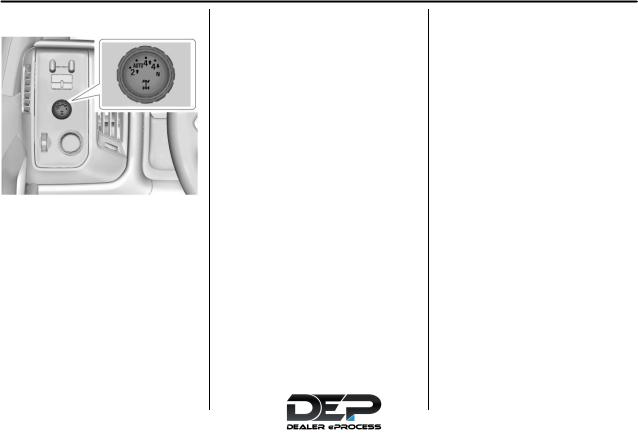
24 In Brief
Automatic Transfer Case
This transfer case knob is to the left of the steering column.
The different drive options that may be available are described following.
2 m (Two-Wheel Drive High) : This setting is used for driving in most street and highway situations.
AUTO (Automatic Four-Wheel Drive) : This setting is ideal for use when road surface traction conditions are variable.
Do not use AUTO mode to park on a steep grade with poor traction such as ice, snow, mud or gravel. In AUTO mode only the rear wheels will hold the vehicle from sliding when parked. If parking on a steep
grade, use 4 m to keep all four wheels engaged.
4 m (Four-Wheel Drive High) : Use this setting when extra traction is needed, such as on snowy or icy roads or in most off-road situations.
N (Neutral) : Shift to this setting only when towing the vehicle. See Recreational Vehicle Towing
0 416 or Towing the Vehicle 0 416.
4 n (Four-Wheel Drive Low) : This setting sends maximum power to all four wheels. Choose 4n when driving in deep sand, mud, or snow, and while climbing or descending steep hills.
See Four-Wheel Drive 0 267.
Vehicle Features
Infotainment System
The base radio information is included in this manual. See the infotainment manual for information on the uplevel radios, audio players, phone, navigation system, Rear Seat Entertainment (RSE), and voice or speech recognition,
if equipped.
Radio(s)
Base Radio
O : Press to turn the system on. Press and hold to turn it off. When on, press to mute; press again to unmute. Turn to increase or decrease the volume.
{ : Press to go to the Home Page.
7 : Press to seek the previous station or track.
6 : Press to seek the next station or track.
See Overview 0 187.

In Brief |
25 |
Setting the Clock
See Clock 0 130.
Satellite Radio
Vehicles with a SiriusXM satellite radio tuner and a valid SiriusXM satellite radio subscription can receive SiriusXM programming.
SiriusXM Satellite Radio
Service
SiriusXM is a satellite radio service based in the 48 contiguous United States and 10 Canadian provinces. SiriusXM satellite radio has a wide variety of programming and commercial-free music, coast to coast, and in digital-quality sound. A fee is required to receive the SiriusXM service.
For more information refer to:
.www.siriusxm.com or call 1-888-601-6296 (U.S.).
.www.siriusxm.ca or call 1-877-438-9677 (Canada).
See Satellite Radio 0 191.
Portable Audio Devices
This vehicle may have a 3.5 mm (1/8 in) auxiliary input jack and USB ports in the center stack, center console, or under the armrest. External devices such as iPods, laptop computers, MP3 players, and USB storage devices may be connected, depending on the audio system.
See USB Port 0 194 and Auxiliary
Jack 0 199.
Bluetooth
The Bluetooth system allows users with a Bluetooth-enabled cell phone to make and receive hands-free calls using the vehicle audio system and controls.
The Bluetooth-enabled cell phone must be paired with the in-vehicle Bluetooth system before it can be used in the vehicle. Not all phones will support all functions.
See Bluetooth (Infotainment Controls) 0 209 or Bluetooth (Overview)
Steering Wheel Controls
If equipped, some audio controls can be adjusted at the steering wheel.
g : For vehicles with OnStar or a Bluetooth system, press to interact with those systems. See OnStar Overview 0 467 or “Bluetooth (Overview)” in the infotainment manual.
i : Press to reject an incoming call or end a current call. Press to mute or unmute the infotainment system when not on a call.

26 In Brief
o or p : Press to go to the previous or next menu option.
w or x : Press to go to the next or previous selection.
V : Press to select a highlighted menu option.
The favorite and volume switches are on the back of the steering wheel.
1.Favorite: When on a radio source, press to select the next or previous favorite. When on a media source, press to select the next or previous track.
2.Volume: Press to increase or decrease the volume.
See Steering Wheel Controls 0 127.
Cruise Control
5 : Press to turn the system on or off. A white indicator comes on in the instrument cluster when cruise control is on and turns off when cruise control is off.
+ RES : If there is a set speed in memory, press briefly to resume to that speed or press and hold to accelerate. If cruise control is already active, use to increase vehicle speed.
SET − : Press briefly to set the speed and activate cruise control. If cruise control is already active, use to decrease vehicle speed.
* : Press to disengage cruise control without erasing the set speed from memory.
See Cruise Control 0 280.
Driver Information
Center (DIC)
The DIC display is in the instrument cluster. It shows the status of many vehicle systems.

In Brief |
27 |
w or x : Press to move up or down in a list.
o or p : Press to move between the interactive display zones in the cluster.
V : Press to open a menu or select a menu item. Press and hold to reset values on certain screens.
See Driver Information Center (DIC) (Uplevel and Denali Cluster) 0 158 or Driver Information Center (DIC) (Base Level Cluster) 0 157.
Forward Collision Alert
(FCA) System
If equipped, FCA may help avoid or reduce the harm caused by front-end crashes. FCA provides a
green indicator, V, when a vehicle is detected ahead. This indicator displays amber if you follow a vehicle too closely. When approaching a vehicle ahead too quickly, FCA provides a flashing red alert on the windshield and rapidly beeps or pulses the driver seat.
See Forward Collision Alert (FCA)
System 0 287.
Forward Automatic
Braking (FAB)
If the vehicle has Forward Collision Alert (FCA), it also has FAB, which includes Intelligent Brake
Assist (IBA). When the system detects a vehicle ahead in your path that is traveling in the same direction that you may be about to crash into, it can provide a boost to braking brake the
vehicle. This can help avoid or lessen the severity of crashes when driving in a forward gear.
See Forward Automatic Braking (FAB) 0 290.
Lane Departure
Warning (LDW)
If equipped, LDW may help avoid unintentional lane departures at speeds of 56 km/h (35 mph) or greater. LDW uses a camera sensor to detect the lane markings. The
LDW light, @, is green if a lane marking is detected. If the vehicle departs the lane, the light will change to amber and flash. In addition, beeps will sound or the driver seat will pulse.
See Lane Departure Warning (LDW)
(2500/3500 Series) 0 291.
Lane Keep Assist (LKA)
If equipped, LKA may help avoid crashes due to unintentional lane departures. It may assist by gently turning the steering wheel if the

28 In Brief
vehicle approaches a detected lane marking without using a turn signal in that direction. It may also provide a Lane Departure Warning (LDW) alert as the lane marking is crossed. The system will not assist or alert if it detects that you are actively steering. Override LKA by turning the steering wheel. LKA uses a camera to detect lane markings between 60 km/h (37 mph) and
180 km/h (112 mph).
See Lane Departure Warning (LDW) (2500/3500 Series) 0 291 and Lane Keep Assist (LKA) (1500 Series)
0 292.
Rear Vision
Camera (RVC)
If equipped, RVC shows a view of the area behind the vehicle on the infotainment display when the vehicle is shifted into R (Reverse) to aid with parking and low-speed backing maneuvers.
See Assistance Systems for Parking or Backing 0 285.
Park Assist
If equipped, Rear Park Assist (RPA) uses sensors on the rear bumper to assist with parking and avoiding objects while in R (Reverse).
It operates at speeds less than 8 km/h (5 mph). RPA may show a
warning triangle on the infotainment display and a graphic on the instrument cluster to provide the object distance. In addition, multiple beeps or seat pulses may occur if very close to an object.
The vehicle may also have the Front Park Assist system.
See Assistance Systems for Parking or Backing 0 285.
Power Outlets
Accessory power outlets can be used to plug in electrical equipment, such as a cell phone, MP3
player, etc.
The vehicle may have up to four accessory power outlets.
Vehicles with a Center Console
.One or two in front of the cupholders on the center console
.One inside the center console
.One on the rear of the center console
Vehicles with Bench Seats
.One on the center stack below the climate control system
.One or two in the storage area on the bench seat
Lift the cover to access and replace when not in use.
See Power Outlets 0 130.

In Brief |
29 |
Universal Remote System Sunroof
If equipped with the Universal Remote system, these buttons will be in the front overhead console.
This system provides a way to replace up to three remote control transmitters used to activate devices such as garage door openers, security systems, and home automation devices.
See Universal Remote System 0 170.
1.SLIDE Switch
2.TILT Switch
If equipped, the sunroof operates when the ignition is on or in ACC/ ACCESSORY, or when Retained Accessory Power (RAP) is active. See Retained Accessory Power (RAP) 0 255.
Slide Switch
Express-Open/Express-Close : To express-open the sunroof, fully
press and release I (1). Press and
release I (1) again to stop the movement. To express-close the sunroof, fully press and
release K (1). Press and release K (1) again to stop the movement.
Open/Close (Manual Mode) : To open the sunroof, press and
hold I (1). Release I (1) to stop the movement. Press and hold K (1) to close the sunroof.
Release K (1) to stop the movement.
